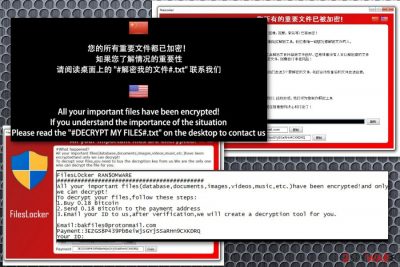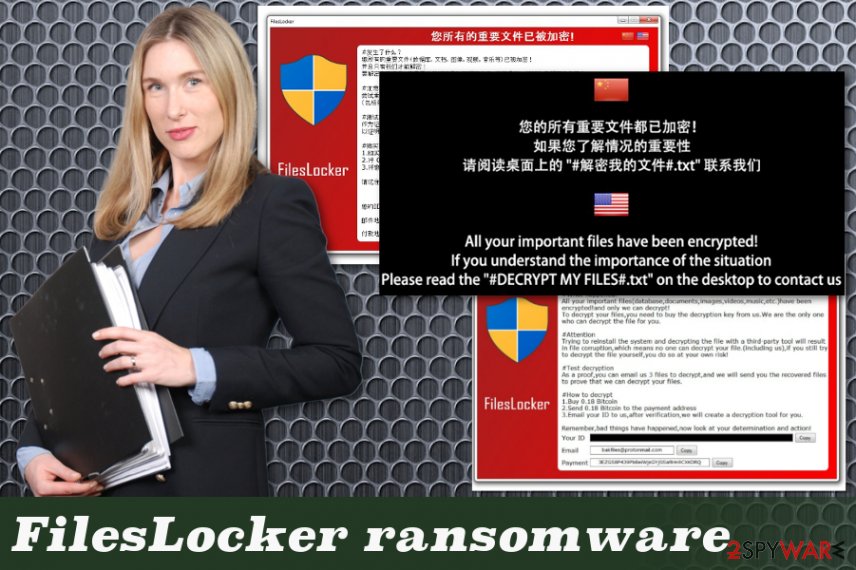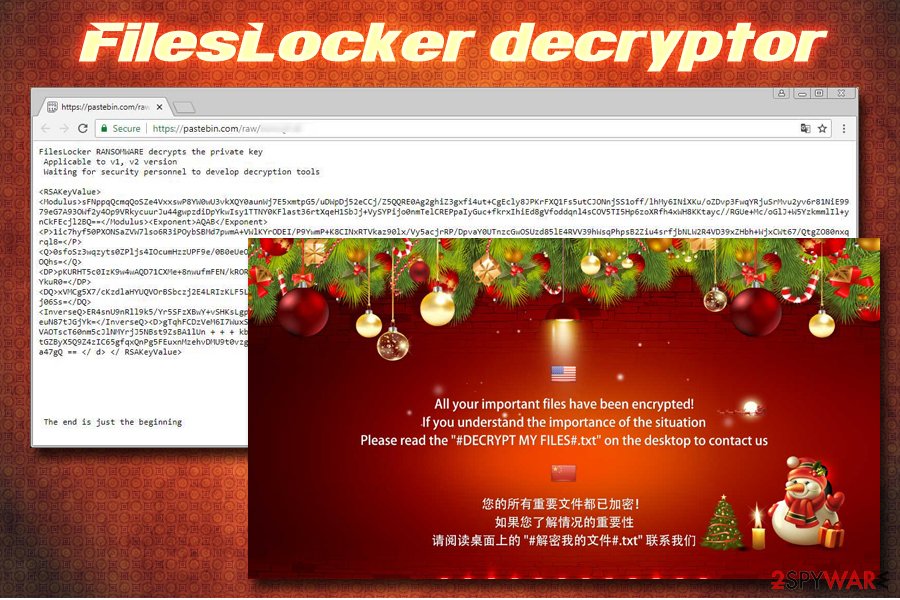FilesLocker ransomware (Virus Removal Instructions) - updated Jan 2019
FilesLocker virus Removal Guide
What is FilesLocker ransomware?
FilesLocker is a crypto malware that was recently decrypted with the help master RSA key

FilesLocker is a ransomware virus that primarily targets Chinese and English users and was first spotted making rounds in late October 2018. Malware uses AES + RSA cipher to encrypt data and appends .locked or .[fileslocker@pm.me] appendix. While .locked file virus uses the same file extension, researchers did not find any association with all previously encountered ransomware viruses. As described by hackers, FilesL0cker RAN$OMWARE places “解密我的文件.txt” and “#DECRYPT MY FILES#.txt” into each of the affected folder. The ransom note demands 0.18 Bitcoins to be sent to the specified address, and also offers free test decryption. According to cybercriminals, after the payment is processed, victims should contact them via bakfiles@protonmail.com. In early December, hackers came back with FilesLocker ransomware v2.0 which appends [fileslocker@pm.me] file extension. Later that month, a new “Christmas Edition” virus came out and loaded up a Pastebin that contains master RSA key, which consequently led to a decryptor development.[1]
| Name | FilesLocker ransomware |
|---|---|
| Also known as | FilesL0cker RAN$OMWARE |
| Type | Cryptovirus |
| Versions | FilesLocker ransomware v2.0 |
| File extension | .locked, .[fileslocker@pm.me] |
| Ransom note |
#解密我的文件#.txt #DECRYPT MY FILES#.txt |
| Targets | Chinese and English-speaking users |
| Contact email | bakfiles@protonmail.com, fileslocker@pm.me |
| Ransom amount | 0.18 BTC; 0.15 BTC (v2.0) |
| Distribution | Spam email attachments, exploits, brute-force attacks, etc. |
| Decryptable? | Yes, .[fileslocker@pm.me] variants. Download decrytor from here [WARNING! Direct download link] |
| Elimination | Use FortectIntego and fix virus damage after FilesLocker ransomware removal |
FilesLocker ransomware has no difficulty to spread around the world because it has been set to use ransom notes written in English and Chinese languages.[2] The whole file encryption process is fairly quick – it only takes three seconds to complete.[3]
As a result, the victim cannot use photos, videos, documents, and even the whole network once the attack is finished. The only way to recognize the infection is by looking at the file extension .locked appended at the end of each file name. However, paying the ransom is not the best solution since cybercriminals are not trustworthy.
The best way to release your data is to recover lost files from a backup. If you have your important files stored on cloud services or an external device, you can replace encoded data with the safe copies. However, you need to remove FilesLocker ransomware from the system first because ransomware can encrypt your newly-added files once again.
This virus is also known as FilesL0cker RAN$OMWARE. While its ransom message is typically placed on the system in both languages, we will provide the ransom note written in English:
FilesL0cker RAN$OMWARE
###########################################
All your important files(database,documents,images,videos,music,etc.)have been encrypted!and only we can decrypt!
To decrypt your files,follow these steps:
1.Buy 0.18 Bitcoin
2.Send 0.18 Bitcoin to the payment address
3.Email your ID to us,after verification,we will create a decryption tool for you.Email:bakfiles@protonmail.com
Payment:3EZGS8P439PbBeiWjsGYjSSaRHn9CXKDRQ
Your ID: –

You need to get rid of the virus before attempting any data recovery. No matter how little the ransom amount looks, it is worth more than $1100 at the moment of writing. Keep in mind that FilesLocker ransomware is a product of hackers who have one goal – extorting money from their victims. We, like any other cybersecurity expert team,[4] recommend staying away from these dangerous people.
If you got infected, make sure to perform FilesLocker ransomware removal using reputable anti-malware of your choice and then clean the system with system repair tools like FortectIntego. This is an important step because various intruders may affect the performance of your computer in different ways and programs like these can fix the system damage.
Also, when it comes to encrypted files and data encryption, you have the only solution – restore encoded data. You can find a few file recovery methods and software suggestions down below the article. Remember that ransomware is a dangerous cyber threat that tends to be persistent, so you may need to enter the Safe Mode before scanning the device. Follow our instructions and eliminate FilesLocker ransomware for good.
Free decryptor for [Fileslocker@pm.me] encrypted files
On 29th of December, security researchers discovered[5] a “Christmas” version of FilesLocker ransomware. Similarly to previous versions, it encrypts files with a strong cipher, drops ransom notes in both, English and Chinese languages, changes the desktop to a Christmas-themed wallpaper and demands 0.3 Bitcoins to be paid to retrieve data.
However, as soon as file encoding procedure is complete, FilesLocker Christmas Edition does something unexpected: it opens a Pastebin URL which also displays the RSA key inside. This key can be used for both, v1 and v2 viruses.
Upon discovery, independent security researcher Michael Gillespie managed to create a functional decryptor which allows users to retrieve data for free. You can download the tool from [direct link follows] here.

Unfortunately, those who use Microsoft's Defender might find it blocked as it is detected as a trojan.[6] We do not take any responsibility for the decryptor's functionality or any other consequences, so please use it at your own risk. In order to download the decryptor, disable Microsoft anti-virus temporarily.
Indeed, it is surprising that cybercriminals decided to give Christmas present to the victims of their ransomware. Nevertheless, the added a small note at the end of Pastebin message:
The end is just the beginning
Hackers might have been feeling festive, but somehow the message hints on more malware variants in the future.
Ransomware payload is hidden on spam email file attachments
The most common distribution technique used by malware creators is spam email campaigns. It is an easy way to spread viruses around the web and infect target devices without spending much time on social engineering.
The email filled with ransomware may look legitimate and safe because it tries to pretend to belong to a known company or service. However, this is the method hackers use for tricking people. Users tend to believe the legitimacy of MS Word or Excel file received thru an email with the subject line “Financial information.”
Pay more attention to what is said in the message and stay away from it if you spot these signs:
- many typos or grammar mistakes;
- not matching company names on the email and file attachment;
- a sender is a service you are not using;
- you cannot answer the email back;
- file attachment is called “Order information” or “Invoice.”
Clean your email box more often, keep your anti-malware tools up-to-date and make sure that you are not installing any suspicious software on the device during installation processes.
Terminate FilesLocker ransomware or any other malicious programs
When it comes to products from crypto extortionists, the main danger is the loss of all your data saved on the system. Because of this fact, you need to remove FilesLocker ransomware without wasting your time and postponing this procedure. Run a full system scan with your reputable anti-malware and get rid of infected files. If you haven't employed such a tool to keep your system safe, feel free to use one of our suggestions.
Use FortectIntego, SpyHunter 5Combo Cleaner or Malwarebytes after FilesLocker ransomware removal and fix remaining virus damage or get rid of any malicious files or programs that may still affect the system of your computer and interfere with data recovery. After the double-checking, you can attempt file restoring using the method of your choice. Follow our methods step-by-step and get rid of the threat completely.
Getting rid of FilesLocker virus. Follow these steps
Manual removal using Safe Mode
Get rid of FilesLocker ransomware virus completely by entering the Safe Mode with Networking before a system scan:
Important! →
Manual removal guide might be too complicated for regular computer users. It requires advanced IT knowledge to be performed correctly (if vital system files are removed or damaged, it might result in full Windows compromise), and it also might take hours to complete. Therefore, we highly advise using the automatic method provided above instead.
Step 1. Access Safe Mode with Networking
Manual malware removal should be best performed in the Safe Mode environment.
Windows 7 / Vista / XP
- Click Start > Shutdown > Restart > OK.
- When your computer becomes active, start pressing F8 button (if that does not work, try F2, F12, Del, etc. – it all depends on your motherboard model) multiple times until you see the Advanced Boot Options window.
- Select Safe Mode with Networking from the list.

Windows 10 / Windows 8
- Right-click on Start button and select Settings.

- Scroll down to pick Update & Security.

- On the left side of the window, pick Recovery.
- Now scroll down to find Advanced Startup section.
- Click Restart now.

- Select Troubleshoot.

- Go to Advanced options.

- Select Startup Settings.

- Press Restart.
- Now press 5 or click 5) Enable Safe Mode with Networking.

Step 2. Shut down suspicious processes
Windows Task Manager is a useful tool that shows all the processes running in the background. If malware is running a process, you need to shut it down:
- Press Ctrl + Shift + Esc on your keyboard to open Windows Task Manager.
- Click on More details.

- Scroll down to Background processes section, and look for anything suspicious.
- Right-click and select Open file location.

- Go back to the process, right-click and pick End Task.

- Delete the contents of the malicious folder.
Step 3. Check program Startup
- Press Ctrl + Shift + Esc on your keyboard to open Windows Task Manager.
- Go to Startup tab.
- Right-click on the suspicious program and pick Disable.

Step 4. Delete virus files
Malware-related files can be found in various places within your computer. Here are instructions that could help you find them:
- Type in Disk Cleanup in Windows search and press Enter.

- Select the drive you want to clean (C: is your main drive by default and is likely to be the one that has malicious files in).
- Scroll through the Files to delete list and select the following:
Temporary Internet Files
Downloads
Recycle Bin
Temporary files - Pick Clean up system files.

- You can also look for other malicious files hidden in the following folders (type these entries in Windows Search and press Enter):
%AppData%
%LocalAppData%
%ProgramData%
%WinDir%
After you are finished, reboot the PC in normal mode.
Remove FilesLocker using System Restore
You may also try to restore the system to a previous state by enabling System restore feature:
-
Step 1: Reboot your computer to Safe Mode with Command Prompt
Windows 7 / Vista / XP- Click Start → Shutdown → Restart → OK.
- When your computer becomes active, start pressing F8 multiple times until you see the Advanced Boot Options window.
-
Select Command Prompt from the list

Windows 10 / Windows 8- Press the Power button at the Windows login screen. Now press and hold Shift, which is on your keyboard, and click Restart..
- Now select Troubleshoot → Advanced options → Startup Settings and finally press Restart.
-
Once your computer becomes active, select Enable Safe Mode with Command Prompt in Startup Settings window.

-
Step 2: Restore your system files and settings
-
Once the Command Prompt window shows up, enter cd restore and click Enter.

-
Now type rstrui.exe and press Enter again..

-
When a new window shows up, click Next and select your restore point that is prior the infiltration of FilesLocker. After doing that, click Next.


-
Now click Yes to start system restore.

-
Once the Command Prompt window shows up, enter cd restore and click Enter.
Bonus: Recover your data
Guide which is presented above is supposed to help you remove FilesLocker from your computer. To recover your encrypted files, we recommend using a detailed guide prepared by 2-spyware.com security experts.If your files are encrypted by FilesLocker, you can use several methods to restore them:
Data Recovery Pro is an alternative method of file restoring if you have no backups
Since there is no decryption tool you are left with fewer file restoring methods, and we listed them for you.
You can recover accidentally deleted files, encrypted data and files lost in other ways using Data Recovery Pro
- Download Data Recovery Pro;
- Follow the steps of Data Recovery Setup and install the program on your computer;
- Launch it and scan your computer for files encrypted by FilesLocker ransomware;
- Restore them.
Use Windows Previous Versions feature fo recover data after FilesLocker ransomware attack
This is a great file restoring feature for Windows users who haven't backed their data before. However, this is helpful if System restore was enabled before
- Find an encrypted file you need to restore and right-click on it;
- Select “Properties” and go to “Previous versions” tab;
- Here, check each of available copies of the file in “Folder versions”. You should select the version you want to recover and click “Restore”.
ShadowExplorer is yet another data recovery method that helps people after FilesLocker ransomware infection
If Shadow Volume Copies remain untouched after the encryption process, you can use ShadowExplorer for data recovery
- Download Shadow Explorer (http://shadowexplorer.com/);
- Follow a Shadow Explorer Setup Wizard and install this application on your computer;
- Launch the program and go through the drop down menu on the top left corner to select the disk of your encrypted data. Check what folders are there;
- Right-click on the folder you want to restore and select “Export”. You can also select where you want it to be stored.
Download free decryptor from [direct download] here.
Finally, you should always think about the protection of crypto-ransomwares. In order to protect your computer from FilesLocker and other ransomwares, use a reputable anti-spyware, such as FortectIntego, SpyHunter 5Combo Cleaner or Malwarebytes
How to prevent from getting ransomware
Do not let government spy on you
The government has many issues in regards to tracking users' data and spying on citizens, so you should take this into consideration and learn more about shady information gathering practices. Avoid any unwanted government tracking or spying by going totally anonymous on the internet.
You can choose a different location when you go online and access any material you want without particular content restrictions. You can easily enjoy internet connection without any risks of being hacked by using Private Internet Access VPN.
Control the information that can be accessed by government any other unwanted party and surf online without being spied on. Even if you are not involved in illegal activities or trust your selection of services, platforms, be suspicious for your own security and take precautionary measures by using the VPN service.
Backup files for the later use, in case of the malware attack
Computer users can suffer from data losses due to cyber infections or their own faulty doings. Ransomware can encrypt and hold files hostage, while unforeseen power cuts might cause a loss of important documents. If you have proper up-to-date backups, you can easily recover after such an incident and get back to work. It is also equally important to update backups on a regular basis so that the newest information remains intact – you can set this process to be performed automatically.
When you have the previous version of every important document or project you can avoid frustration and breakdowns. It comes in handy when malware strikes out of nowhere. Use Data Recovery Pro for the data restoration process.
- ^ Michael Gillespie. #FilesLocker #Ransomware . Twitter. Social Network.
- ^ Selena Larson. New ransomware attack hits Russia and spreads around globe. CNN. Breaking news.
- ^ The speed of ransomware: 3 seconds to encryption. CSO. Security news, features and analysis.
- ^ Viirused. Viirused.
- ^ MalwareHunterTeam. FilesLocker v2 "Christmas" ransomware. Twitter. Social Network.
- ^ 1e1d94bb5c62dc103a914a910cc3a6ef96d2bfbc74d8cb48d6e622322ed0b11f. Virus Total. Internet security, file and URL analyzer.





















